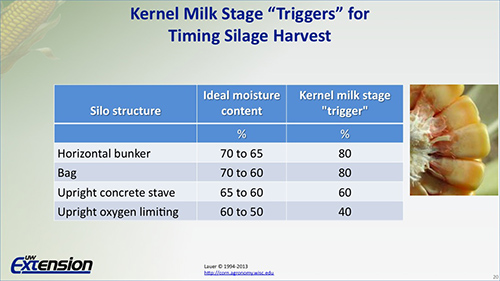 Joe Lauer, University of Wisconsin, shared "Growing high yield and high quality corn silage in the northern Corn Belt" on the December 9 webinar, sponsored by Kuhn North America. There are different goals when producing corn silage. Some aim for high yields, while others choose quality over quantity. But, quality means different things to different growers and feeders, but the proof is ultimately seen in how the cow performs after consuming it.
Joe Lauer, University of Wisconsin, shared "Growing high yield and high quality corn silage in the northern Corn Belt" on the December 9 webinar, sponsored by Kuhn North America. There are different goals when producing corn silage. Some aim for high yields, while others choose quality over quantity. But, quality means different things to different growers and feeders, but the proof is ultimately seen in how the cow performs after consuming it.It is not as simple as it may seem; weather wreaks havoc on the best-laid plans. Wet springs mean a lack of root surface area, making drainage critical for a successful crop. Also, if the ground is too wet, herbicides will not activate. Dry and hot conditions at the wrong time stop growth and limit yields. Corn and people like the same type of temperatures, at 86°F corn shuts down.

When selecting corn silage options:
• Pay attention to performance
• Pay attention to seed costs
• Every hybrid must stand on its own performance (and not rely on the family's performance).
• Buy the traits you need for your particular growing area
• Traits do not add to yield, they protect yield
The planting date sets up the season. Field conditions determine planting time, but planting too early can jeopardize crop insurance if done too soon. Other problems with planting too soon include seedling diseases, soil crusting, late spring frost and European corn borer.
Harvest timing is critical as well. Harvesting at too high a moisture can reduce yield, cause poor fermentation, seepage and poor intakes. On the flip side, too dry plant conditions can reduce yields, cause mold, and lower digestibility, and protein and vitamin levels. Scheduling can be a challenge with custom operators, who must allocate their labor and equipment among many fields and clients. Not everyone is going to get the optimal harvest time. But look at the planting date, tasseling date and do a final check prior to chopping to see that you have selected the best time to harvest. The best plant moisture level at chopping depends on how and where you will store the silage.

Rotating corn silage with other crops will boost production 10 to 19 percent; this is usually done with wheat or alfalfa.
Another way to maximize production is through pest management. Control weeds early as corn silage is sensitive to weed pressure. Yield suffers when weeds get ahead of you.
Adjust the space between rows can be adjusted to maximize corn plant populations. With narrower rows, you can realize up to one-half ton of corn silage per acre. Some are even planting twin rows and seeing an jump of 2 to 3 bushels.
Corn loves nitrogen, and the lost phosphorus and potassium must be replaced. Dairy manure is an effective option. Altering the cutter bar height can alter yields by as much as 10 percent, as well as affect corn silage nutrient levels.
This webinar will be archived and able for viewing at the end of the week. Past webinars can be found at www.hoards.com/webinars.

The author is the online media manager and is responsible for the website, webinars and social media. A graduate of Modesto Junior College and Fresno State, she was raised on a California dairy and frequently blogs on youth programs and consumer issues.








